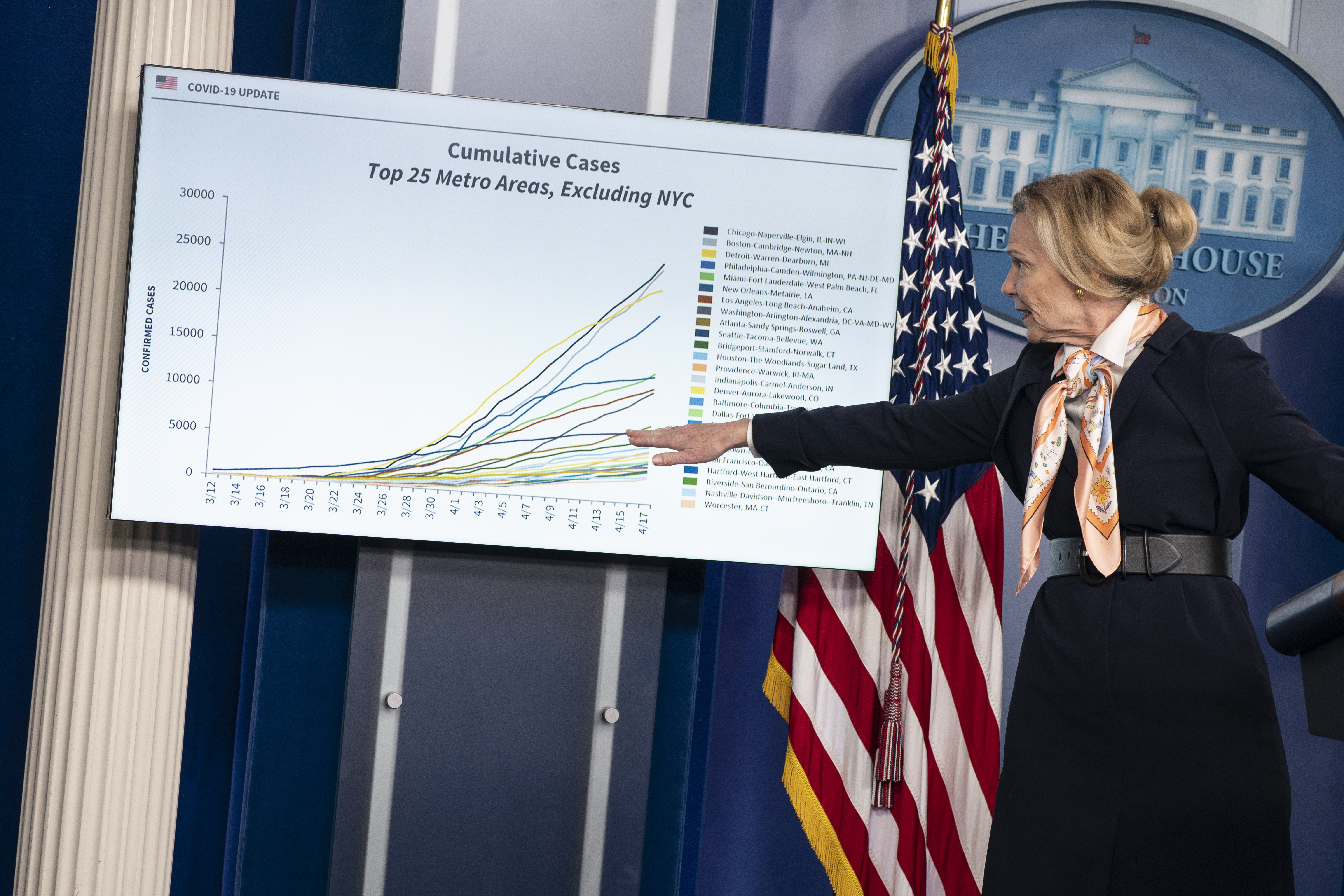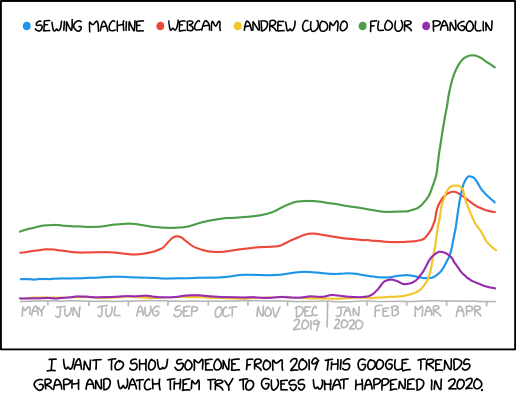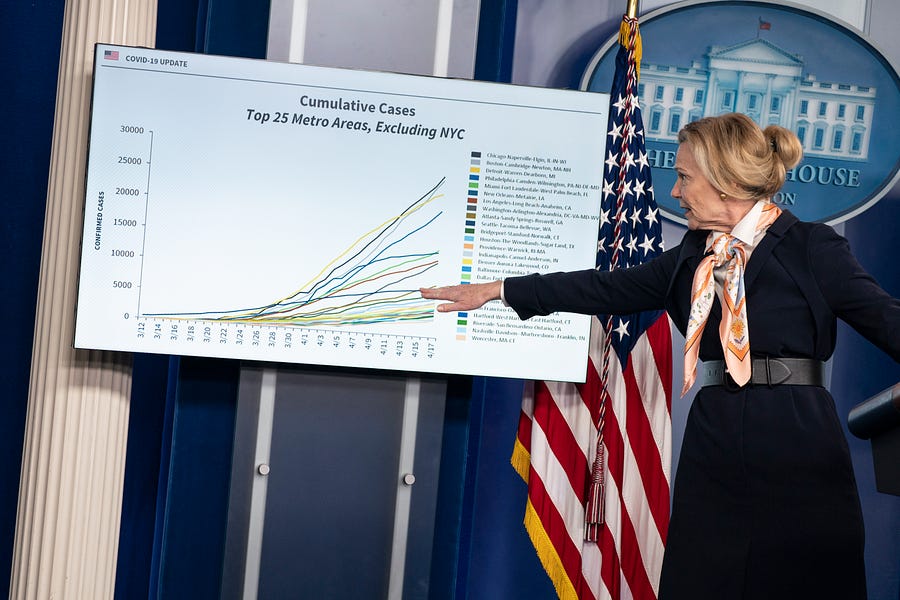Happy Tuesday! We have excellent news. Baseball is back. It may be Korean baseball, and it may air at 1 a.m. But baseball is back.
To get up to speed, check out Mina Kimes’ masterclass on the art of the South Korean bat flip for ESPN a few years back.
Quick Hits: Today’s Top Stories
-
As of Monday night, there are now 1,180,288 confirmed cases of COVID-19 in the United States (an increase of 22,247/1.9 percent since yesterday) and 68,922 deaths (an increase of 1,240/1.8 percent increase since yesterday), according to the Johns Hopkins University COVID-19 Dashboard, leading to a mortality rate among confirmed cases of 5.8 percent (the true mortality rate is likely lower, but it’s impossible to determine precisely due to incomplete testing regimens). Of 7,285,178 coronavirus tests conducted in the United States (231,812 conducted since yesterday), 16.2 percent have come back positive. Meanwhile, 187,180 have recovered from the virus (an increase of 7,028/3.9 percent since yesterday).
-
Secretary of the Senate Julie Adams declined Joe Biden’s request to conduct a search for any personnel files relating to Tara Reade’s allegation against the former Delaware senator, saying in a statement she “has no discretion to disclose any such information.”
-
The Treasury Department announced yesterday that it is borrowing a record-setting $3 trillion this quarter, primarily to fund pandemic relief efforts.
-
Don Shula—the winningest coach in the history of the National Football League who led the Miami Dolphins to two Super Bowl championships and the only undefeated season in league history—passed away on Monday at 90.
Model Magic

As more and more places in America grapple with the question of whether it’s time to begin venturing back out into the world, accurate information about the prospects of the pandemic is more important than ever. Unfortunately, the pandemic modeling picture is only growing murkier, making it difficult for even the most attentive citizens and policymakers to get a solid grasp on where we stand.
From the earliest days of the crisis, Trump administration officials have habitually trotted out a specific projection from the University of Washington’s Institute for Health Metrics and Evaluation—the much-discussed IHME model. By tracking and reporting how a single model changed over time, administration voices like Dr. Deborah Birx and Dr. Anthony Fauci were able to provide a simple narrative for how well the U.S. was doing in its fight against the virus.
The problem is that the IHME model has turned out not to be particularly good. As its estimations of expected deaths yo-yoed around wildly throughout April, many experts quickly soured on it. Harvard epidemiologist Marc Lipsitch said it was not “well-suited” to projecting COVID-19 deaths; Dr. Ruth Etzioni of the Fred Hutchinson Cancer Center said that the fact that the model kept changing “is evidence of its lack of reliability as a predictive tool” and argued that it was a “travesty” that it was being used for policy decisions. Along the way, the model picked up major critics in both left and right-leaning media, further undercutting its credibility to the public as a useful national assessment of current policy. (The model went through its latest whiplash recalibration just yesterday, snapping from an estimated 72,433 deaths all the way up to nearly 135,000.)
Unfortunately, waning confidence in the predictive power of the IHME model has not caused it to be replaced by anything more substantive. Indeed, the picture coming out of the White House is getting more and more convoluted, as a number of bizarre modeling-related news events yesterday demonstrated.
First, there was the grim morning headline in the New York Times: Leaked internal government projections estimated things would get far worse than previously believed. Neither the infection rate nor the death rate was anywhere close to peaking, these projections seemed to say: By June 1, 3,000 Americans would be dying per day, with another 200,000 a day coming down with the virus. Very bad news!
But not so fast, the model’s creator, Justin Lessler, an associate professor of epidemiology at the Johns Hopkins Bloomberg School of Public Health, told the Washington Post: Those projections were incomplete, never meant to be treated as a forecast at all, let alone slapped on CDC slides and shared with the media. He had no idea, he said, how they had gotten into the public eye at all.
Then there was the news yesterday of another new estimation: a so-called “cubic model” being put forward in the White House by Trump adviser Kevin Hassett. The Post reported that that model showed deaths dropping off a cliff this month and drying up almost entirely by May 15.
It’s unjust to be too unkind to the forecasters (though any “model” showing zero deaths in 10 days deserves mocking). Sniping at inaccurate models is easy; accurately modeling how a brand-new virus will spread and how many it will kill is very, very hard when we know so little. But the fact remains that months into the pandemic, we still lack a clear national picture of how bad things are likely to get under various reopening scenarios—which makes it exceedingly difficult for people to make informed decisions about what comes next.
It’s also fair to ask at this point whether it’s overly simplistic to consider the U.S. as existing on a single epidemiological curve at all. Many politicians in less powerfully affected states have groused for weeks that the U.S. is keying its response to the virus off a few small crisis spots, particularly in the Northeast. But that concentration of hotspots might also have contributed to a false sense of security that the rest of the country has completed the task of flattening the first infection curve. Over the last month, the rate of daily new coronavirus cases across the U.S. has slowly declined. But when you exclude New York, New Jersey, Connecticut, and Massachusetts from the count, you find that the opposite has been true: The rate of daily new cases has still not stopped rising.
To put it another way: The fact that our major early hotspots are further along the curve than the rest of the country masks the fact that the rest of America is still getting sicker at an accelerating rate.
It’s plain by now that everyone simply remaining in their homes until the virus has run its course is an unsustainable proposition. The best-case scenario here is that economic reopening is careful enough, and people remain conscientious enough, that we stave off the worst of the economic carnage without bringing down a terrible viral reckoning on ourselves.
But there’s also a worst-case scenario to contemplate: That as Americans venture back out, beat down from two months of isolation and stagnation but happy that we all pitched in to thwart disaster and confident that the worst is now behind us, we find ourselves a few weeks later back in the same place on the curve as we were a month ago.
A Game of Telephone at the Supreme Court
On Monday, the Supreme Court convened to hear its first case since mid-March after delaying the term’s remaining oral arguments in light of COVID-19. But a lot had changed. The advocates didn’t get to crank the podium to adjust its height. There were no heavy red drapes with gold trim flanking the marble columns. Justice Thomas wasn’t leaning all the way back in his imposing black leather chair in silence.
History was made as the court instead convened by telephone and allowed the audio to be broadcast live. The justices, six of whom are 65 years old or older, each had about three minutes to ask their questions from their respective locations and were called on by Chief Justice John Roberts in order of their seniority on the Court.
Notably for avid court followers, Justice Thomas asked questions of the advocates for only the third time since 2006. And in a setting where only 17 percent of advocates last year were women, both sides were represented by female attorneys—Erica Ross, who said she would don the traditional morning coat for advocates representing the solicitor general’s office even if the justices couldn’t see her, and Lisa Blatt of Williams & Connolly LLP, who has argued more cases before the Supreme Court than any other woman.
The May argument calendar, which now includes some cases from the postponed March and April sittings, is also notable for the number of high profile cases the justices will hear over the six days of oral arguments. Whether teachers at religious schools are protected by anti-discrimination laws, the birth control mandate in the ACA, the subpoenas of the President’s financial records, and states that want to punish ‘faithless’ electoral college members are among some of the topics being heard this week and next.
Worth Your Time
-
If you think today’s youth have a problem with screens, apparently kids under the age of 6 in 1969 averaged 55 hours of TV per week! For The New Yorker, Jill Lepore explores the history of Sesame Street—a show created in the hopes of using those 55 hours more productively—and how it’s holding up a half-century later. “Educational television for preschoolers seemed to solve two problems at once: the scarcity of preschools and the abundance of televisions,” she writes. “At the time, half of the nation’s school districts didn’t have kindergartens. To address an achievement gap that had persisted long after Brown v. Board of Education, it would have been better to have universal kindergarten, and universal preschool, but, in the meantime, there was universal television.”
-
For some time now, there have been calls on both the left and the right to “reform” capitalism, or update it for the 21st century. In some quarters, the coronavirus pandemic and our flat-footed response to it has only intensified these calls. In a newsletter published yesterday, Hudson Institute economist Irwin Stelzer writes, “The survival of capitalism depends on its acceptance by a majority of people working, buying, selling and, in the end, dividing the wealth created by the system in a manner generally regarded as ‘fair’. Definitions of that elusive concept vary, but repeated proof that the system is unfair, rigged, loaded in favour of the wealthiest and hence most powerful, is obvious to the untutored eye now that COVID-19 has removed all blinkers. Also obvious is that the moral underpinnings that Adam Smith and more recently historian Gertrude Himmelfarb argued are necessary to the proper functioning and acceptance of capitalism, have been eroded. No, not by Bernie Sanders, not by the increasingly left-surging Democratic Party, try as they might, but by capitalists and their functionaries. As Pogo memorably put it, ‘We have met the enemy and he is us.’”
-
Over at The American Conservative, Rod Dreher has an interesting piece about so-called “folk libertarianism,” a phrase coined by NYT columnist Ross Douthat to describe the brand of “reflexive Ayn Randism and Panglossian hyper-individualism” that characterizes much anti-government sentiment on the right, and how it relates specifically to directives that people should wear masks in public.
Something Fun

(From xkcd.com)
Presented Without Comment
Also Presented Without Comment
Also Also Presented Without Comment
Toeing the Company Line
-
For more on the Supreme Court, check out yesterday’s Advisory Opinions! Sarah and David broke down the court’s first day of teleconferenced oral arguments and previewed cases coming up later this month. Listen in for an in-depth look at Our Lady of Guadalupe School v. Morrissey-Berru and an update on the U.S. women’s national soccer team’s equal pay lawsuit.
-
The Supreme Court is hearing a case today with serious ramifications about the government’s ability to compel speech. Casey Mattox, a senior fellow at the Charles Koch Institute, had a piece on the website yesterday breaking down everything you need to know about the matter.
-
Today on the site, Brian Riedl looks at what the spending we’re doing to prop up the economy is doing to the federal budget deficit, and the math is a little scary: Washington will spend an unheard of $49,000 per household this year.
Let Us Know
Between Declan’s piece yesterday and the item about modeling this morning, we’ve been thinking a lot about all the different scenarios that could play out in the coming weeks and months.
But we imagine you have been, too, and wanted to check in and get a status report. How are you feeling about things? Do you live in a state where the governor has started to loosen restrictions? If so, are you venturing out for work, or to get that much-needed haircut? When will you feel comfortable returning to some semblance of society? How much risk are you willing to take on?
Reporting by Declan Garvey (@declanpgarvey), Andrew Egger (@EggerDC), Sarah Isgur (@whignewtons), and Steve Hayes (@stephenfhayes).
Photograph by Sarah Silbiger/Getty Images.







Please note that we at The Dispatch hold ourselves, our work, and our commenters to a higher standard than other places on the internet. We welcome comments that foster genuine debate or discussion—including comments critical of us or our work—but responses that include ad hominem attacks on fellow Dispatch members or are intended to stoke fear and anger may be moderated.
With your membership, you only have the ability to comment on The Morning Dispatch articles. Consider upgrading to join the conversation everywhere.